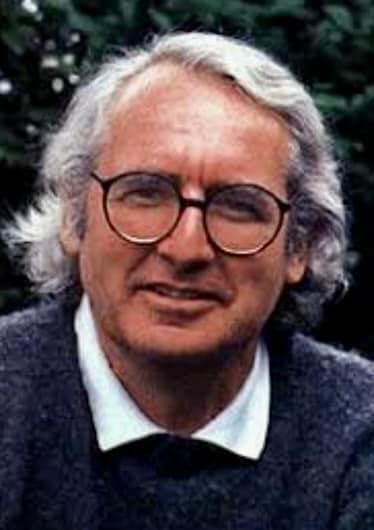hugoklico Deja un comentario Editar
Richard Meier (Newark, 1934) is an American architect and abstract artist, winner among others of the Pritzker Prize and the Gold Medal of the American Institute of Architects (AIA).

His works have focused mainly on museums, large mansions, temples and offices, in which the light in their spaces and the use of the color white stand out, where the spaces harmonize with the surrounding nature.
Member
- American Academy of Arts and Letters.
*American Academy of Arts and Sciences.
- Academy of Architecture.
Distinctions

*Member of the American Academy of Arts and Sciences.
- Rome Prize (1974).
*Pritzker Prize (1984).
- RIBA Gold Medal (1988).
- AIA Gold Medal (1997).
- Praemium Imperiale (1997).
He has also been awarded the Premium Imperiale by the Japan Art Association.

Between 1970 and 1976 he was one of the members of the group of architects known as The New York Five, along with Michael Graves, Peter Eisenman, John Hejduk and Charles Gwathmey.
Shortly after receiving the Pritzker Prize, Meier was commissioned to design the Getty Center in Los Angeles, a large complex of buildings.

Another important project is the Jubilee Church, in Rome.

To celebrate the Jubilee year of 2000, the Holy See organized an international competition for the construction of a new parish in Tor Tre Teste, on the outskirts of Rome.
Meier’s project was the winner, after competing with other architectural greats such as Tadao Ando, Santiago Calatrava, Frank Gehry and Peter Eisenmann.

Its Macba museum, in Barcelona’s Raval, contributed to improving the image of the neighborhood.
The Jubilee Church in Rome revitalized the nondescript neighborhood of Tor Tre Teste.
The rational use of geometry, the clarity of spaces, the superb management of light and the use of the color white as a symbol of purity articulate the work, as well as all of Meier’s work.

At 85 years old, Richard Meier continues to surprise with unique buildings, such as the new luxury residential tower he signed in Taiwan. Occupying a prominent location in the Xin-Yi district, the cultural and financial heart of Taipei, the public use tower has 31 floors. For this new adventure, the architect has turned to some of his «basics»: a facade with a rhythmic cadence, interiors with sublime proportions and a white exterior that shines in the Taipei sun.
The North American architect also moves within sustainability parameters, and tries to sign environmentally friendly projects.

«I do a project and I panic. Which is good, it can be a method.
First, the panic.
Second, conquer panic by working. Third, find ways to resolve your doubts.
Eduardo Souto de Moura (Oporto, 1952) is a Portuguese architect, winner of the 2011 Pritzker Prize, with work closely linked to that of the also Portuguese Álvaro Siza and Fernando Távora, his mentors.
The main features of its architecture include rigor and precision in forms, and a deep sensitivity to the context. Like Álvaro Siza, Souto de Moura cares about the physical environment that surrounds his works, he also takes care of the details and the selection of local materials, combining concrete, stone, wood and aluminum. He is often considered a representative of critical regionalism (of a style introduced by architectural historian Kenneth Frampton).
He won the Pritzker Prize – considered the Nobel Prize for Architecture – with his vocation for designing buildings that are integrated into the environment. His buildings demonstrate an interest in minimalism and wanting to make the lives of the people who live in them easier. Hence, his conception of single-family homes with one or two floors is his hallmark, as well as the care he takes to adapt the construction to the place where it is located, recognizing the work of the architect who with «talent, vision and commitment» contributes to the development of humanity with its architectural work.
Souto de Moura believes that what changes may be the materials, means and construction systems, but that the idea of a house is a universal concept that has not evolved much throughout history.

«My advice to anyone who asks me how to make a house is to have nothing, just some shelves for books, some pillows to sit on. And then, take a stand against the ephemeral, against passing trends… and return to lasting values». Gae Aulenti.
Gaetana Aulenti (Palazzolo dello Stella, Udine, 1927 – 2012 Milan) was an Italian architect, set designer and industrial designer.
Aulenti is known for several large-scale museum projects in the 1980s. In 1981 she was chosen to renovate the Orsay train station in Paris, originally designed by Victor Laloux (Tours 1850 – 1937 Paris) into the Musée d’Orsay. The space exhibits works by French artists from 1848 to 1915. This work led to commissions such as the Italian Pavilion at the 1992 Universal Exhibition in Seville, the commission to create a space for the National Museum of Modern Art in the Georges Pompidou Center in Paris, the restoration of the Palazzo Grassi as an art museum in Venice (1985); the conversion of a former Italian embassy in Berlin into an Academy of Sciences and the renovation of the National Palace of Montjuïc (Barcelona) as the National Museum of Art of Catalonia (1985). In San Francisco, he converted the city’s Central Library into a museum of Asian art. In 2008 he carried out the restoration of the Palazzo Branciforte in Palermo. In 2011, Aulenti oversaw the expansion of Perugia Airport.
She understood that to effectively design domestic environments, it was necessary to establish a dialogue with the elements and qualities of the urban environment. In this way, architectural forms could be generated in which the private and public spheres shared their formal and stylistic complexity. Part of her archives are housed in the International Archive of Women in Architecture at Virginia Tech.
Sugerencia, leer:
———————————————————–
Our Blog has obtained more than 1,300,000 readings: http://onlybook.es/blog/nuestro-blog-ha-superado-el-millon-de-lecturas/

Arq. Hugo A. Kliczkowski Juritz
Onlybook.es/blog
hugoklico.blogspot.com
Post navigation
Entrada anterior3 Arquitectos Pedro Ramírez Vázquez, Fernando Távora y Luis Barragán -z-Entrada siguiente3 Arquitectos Teodoro Fernández Larrañaga, Julio Agustín Vilamajó Echaniz y Jacopo Barozzi de Vignola -Ab-